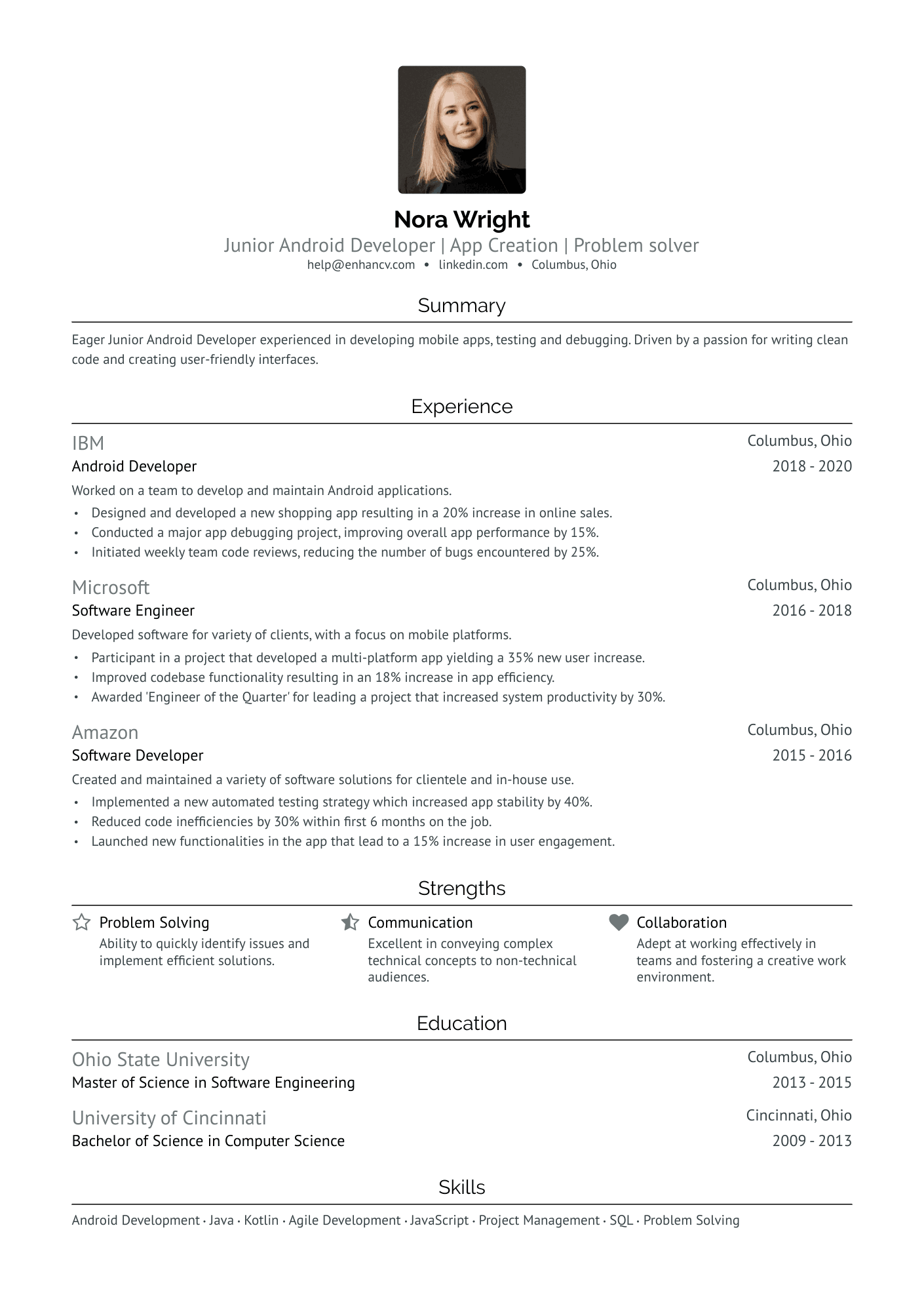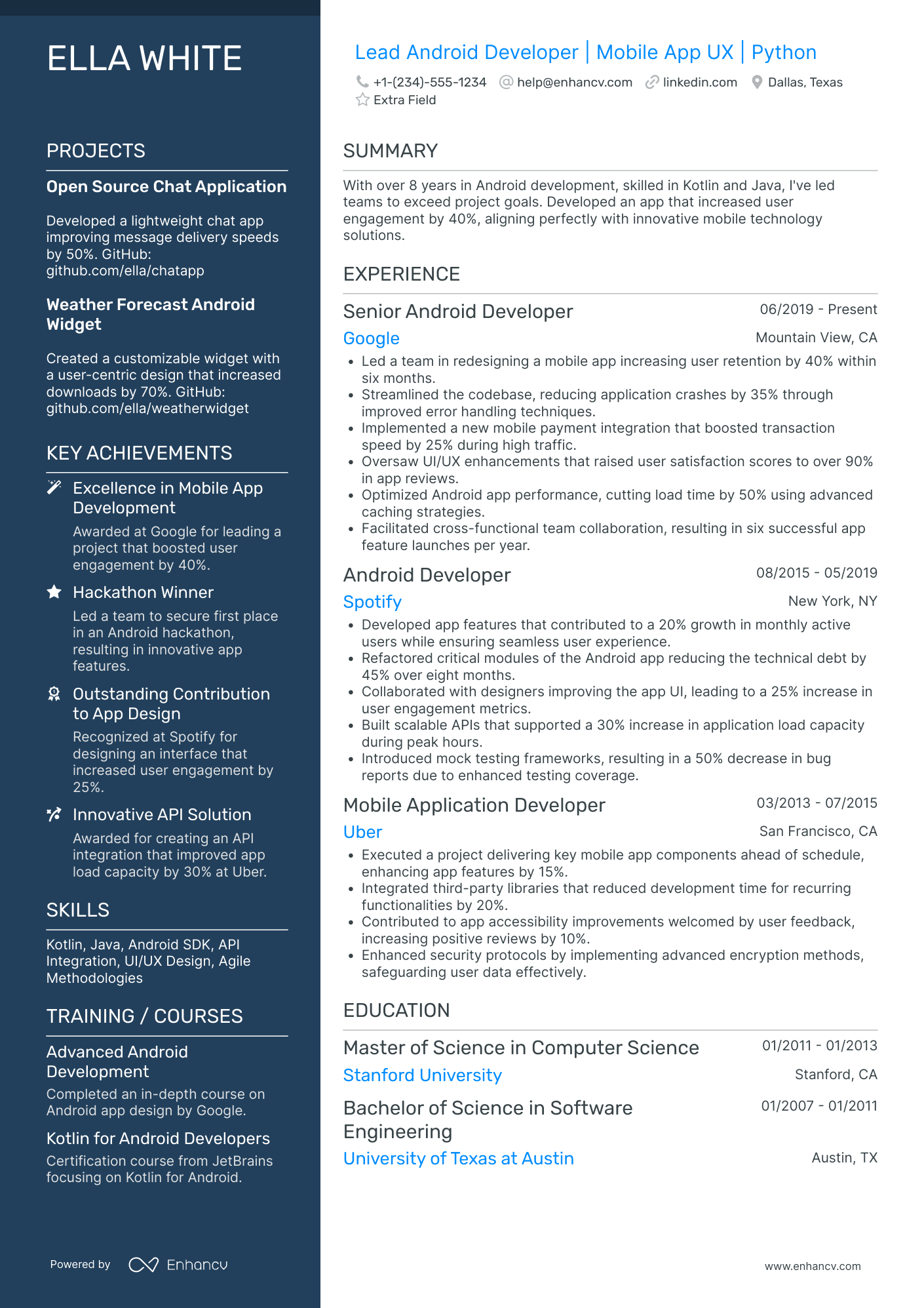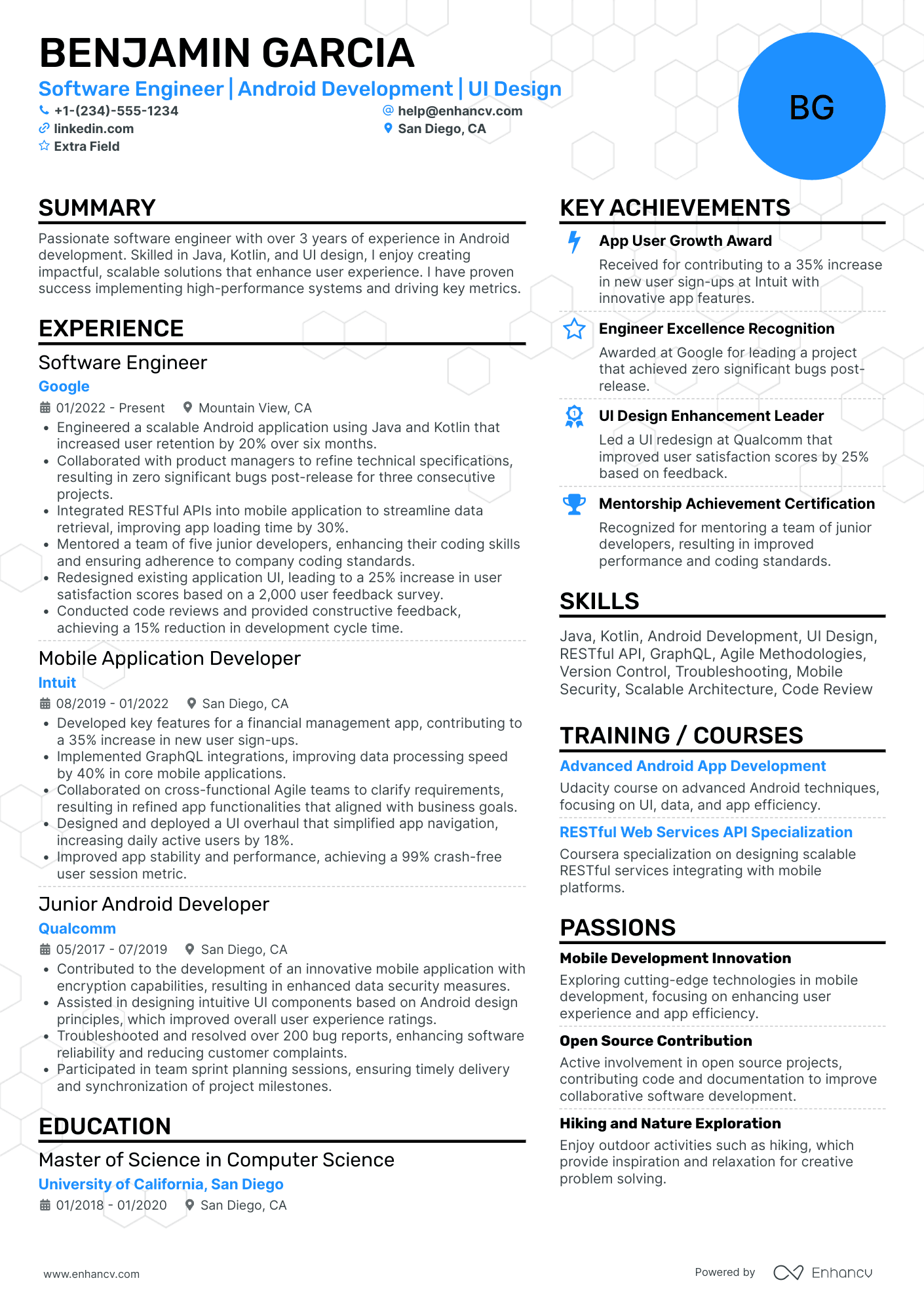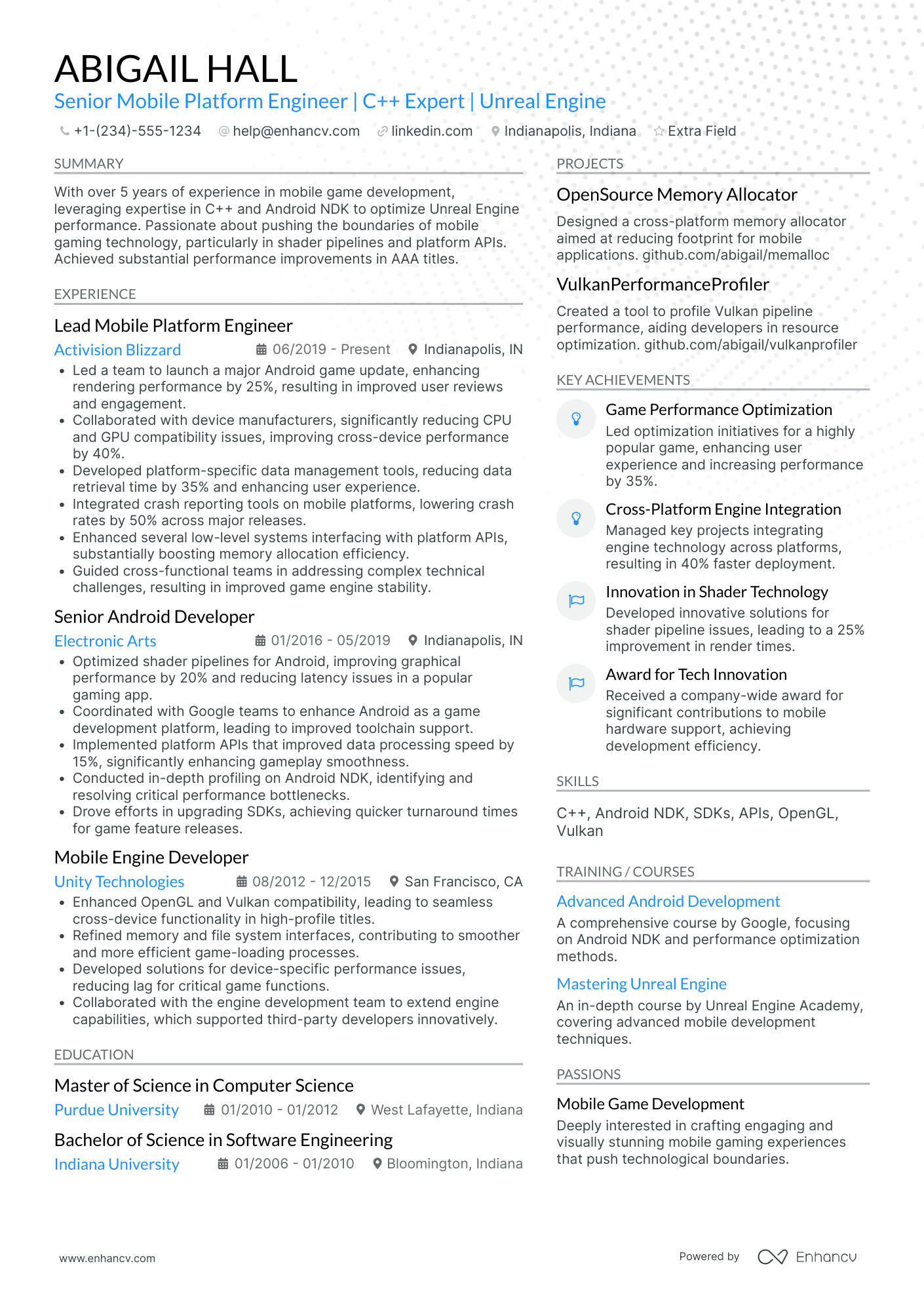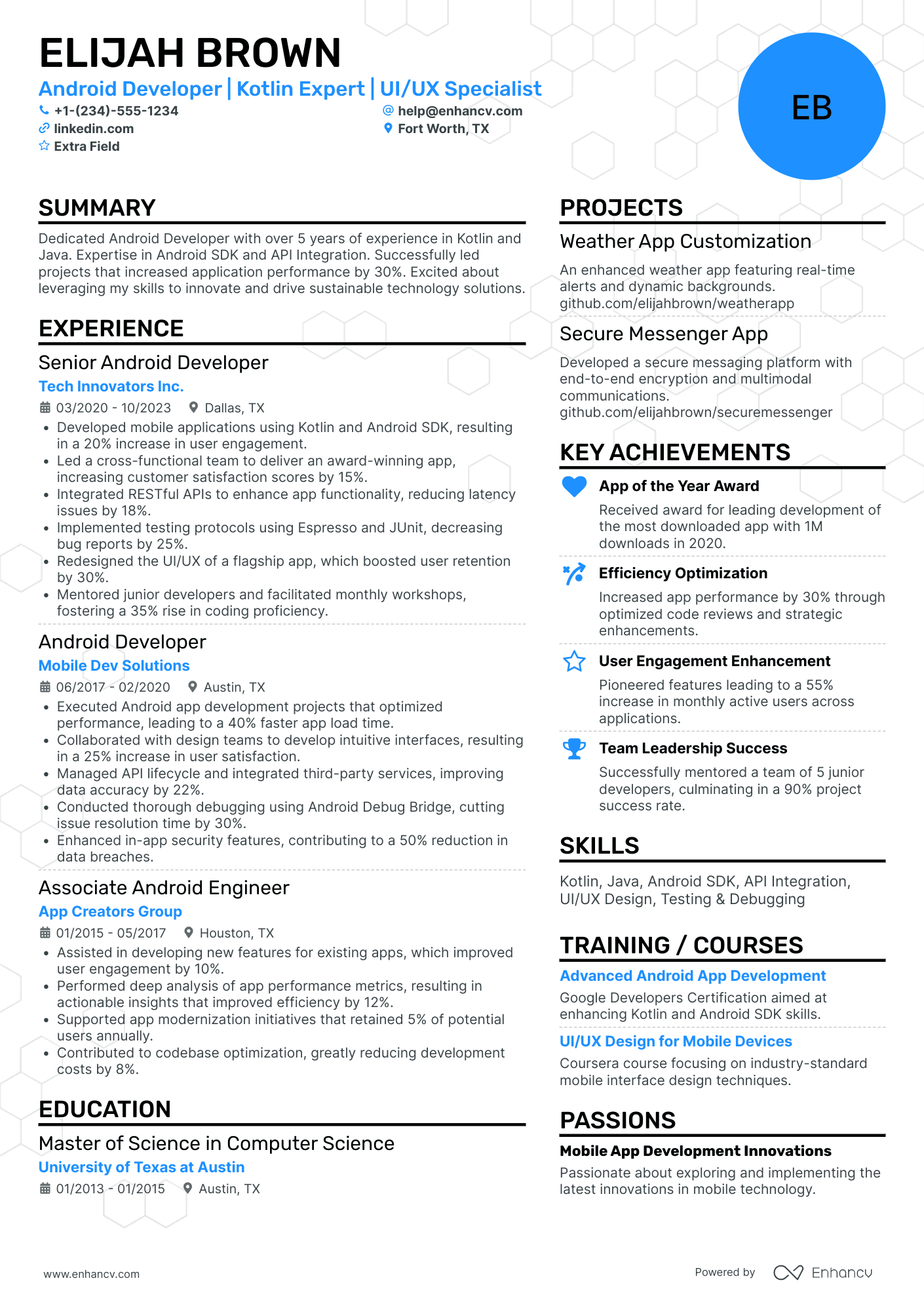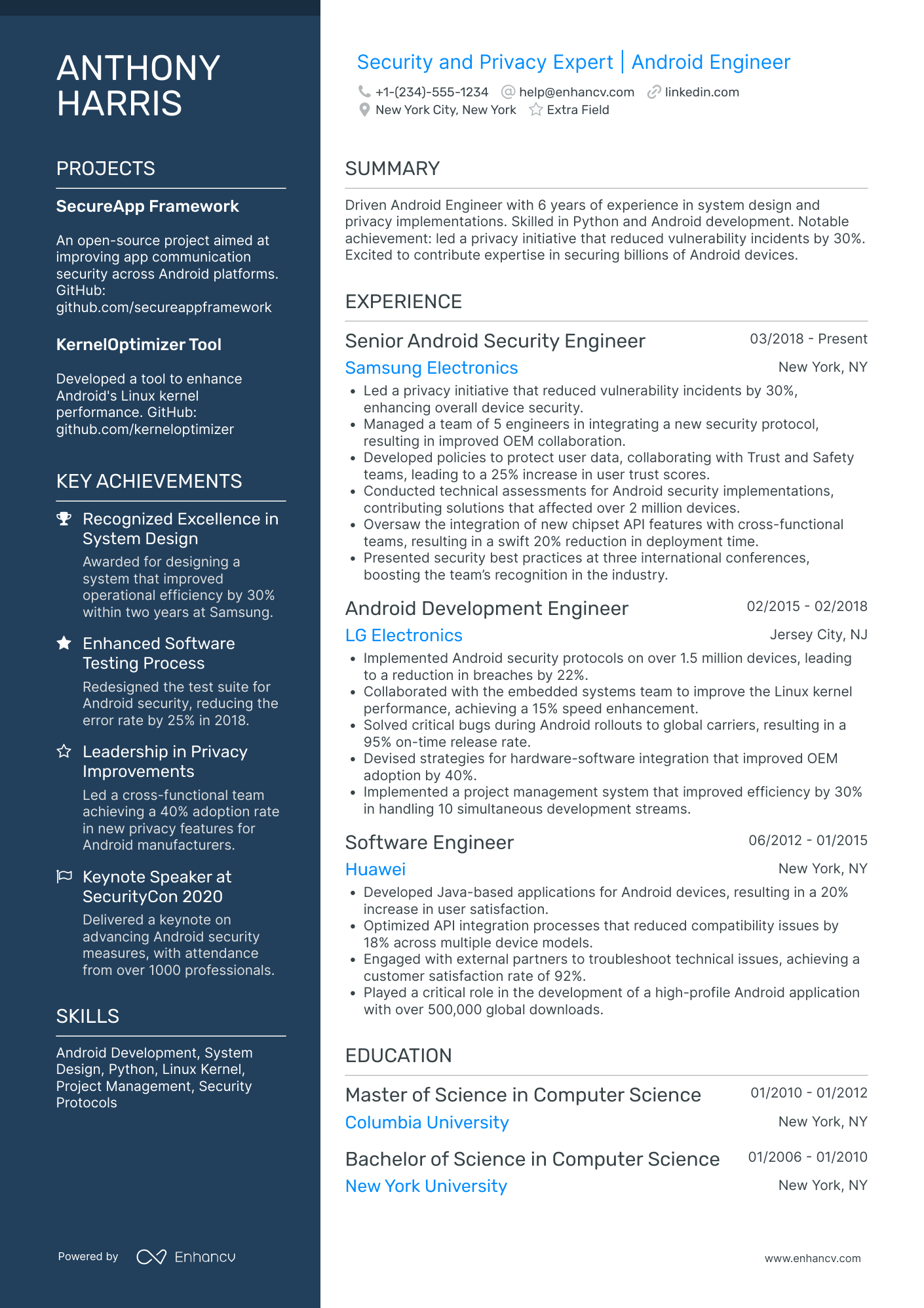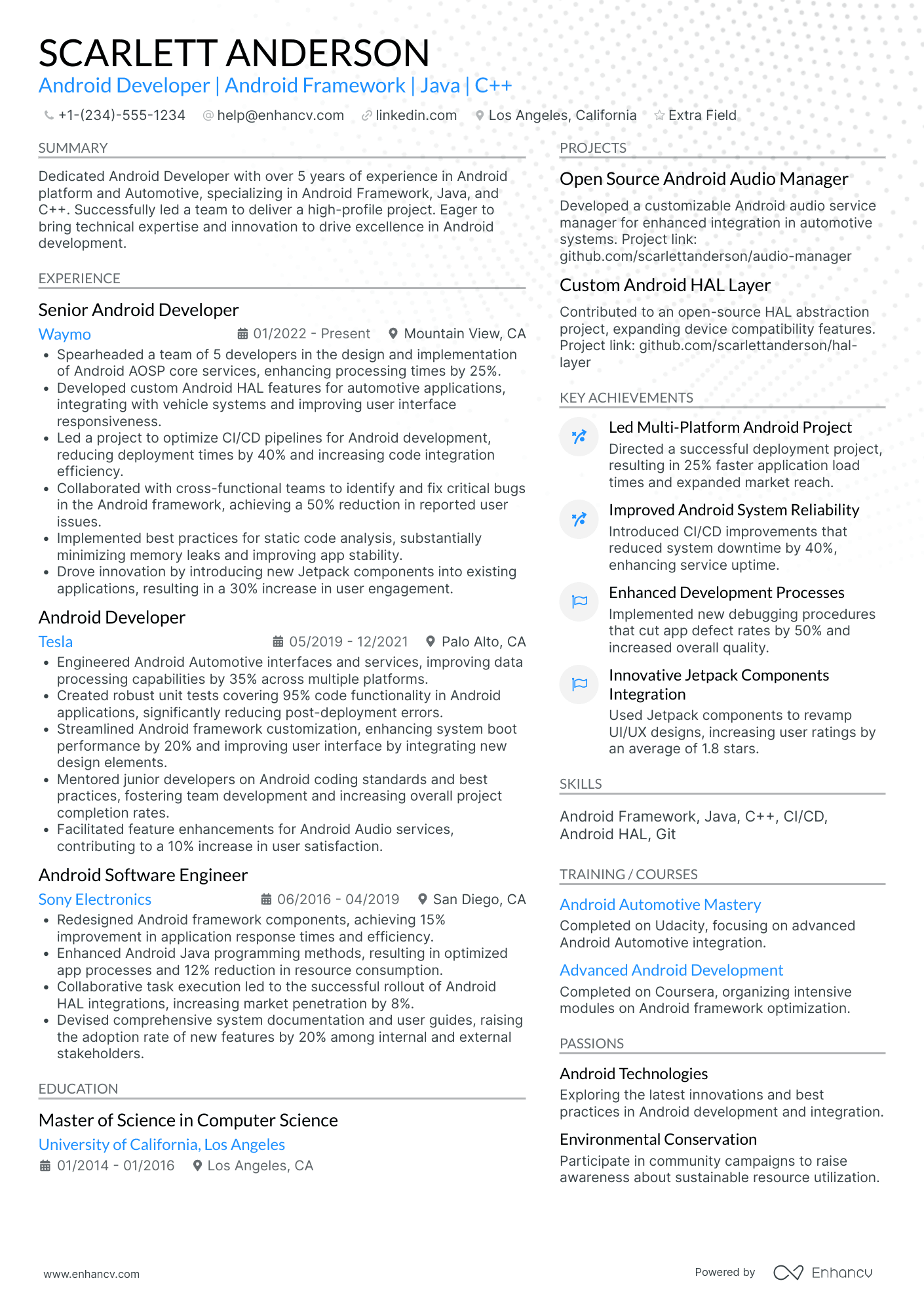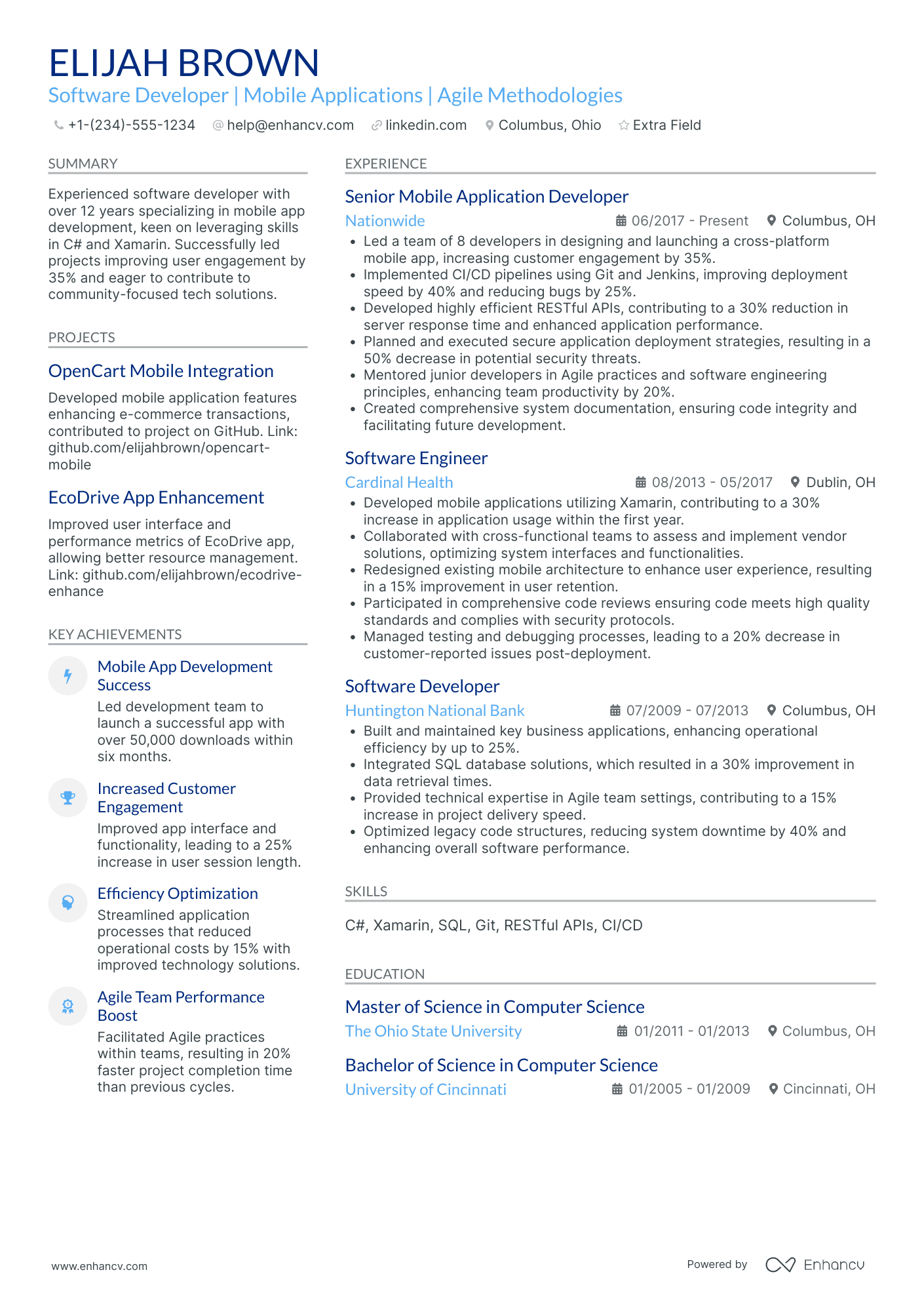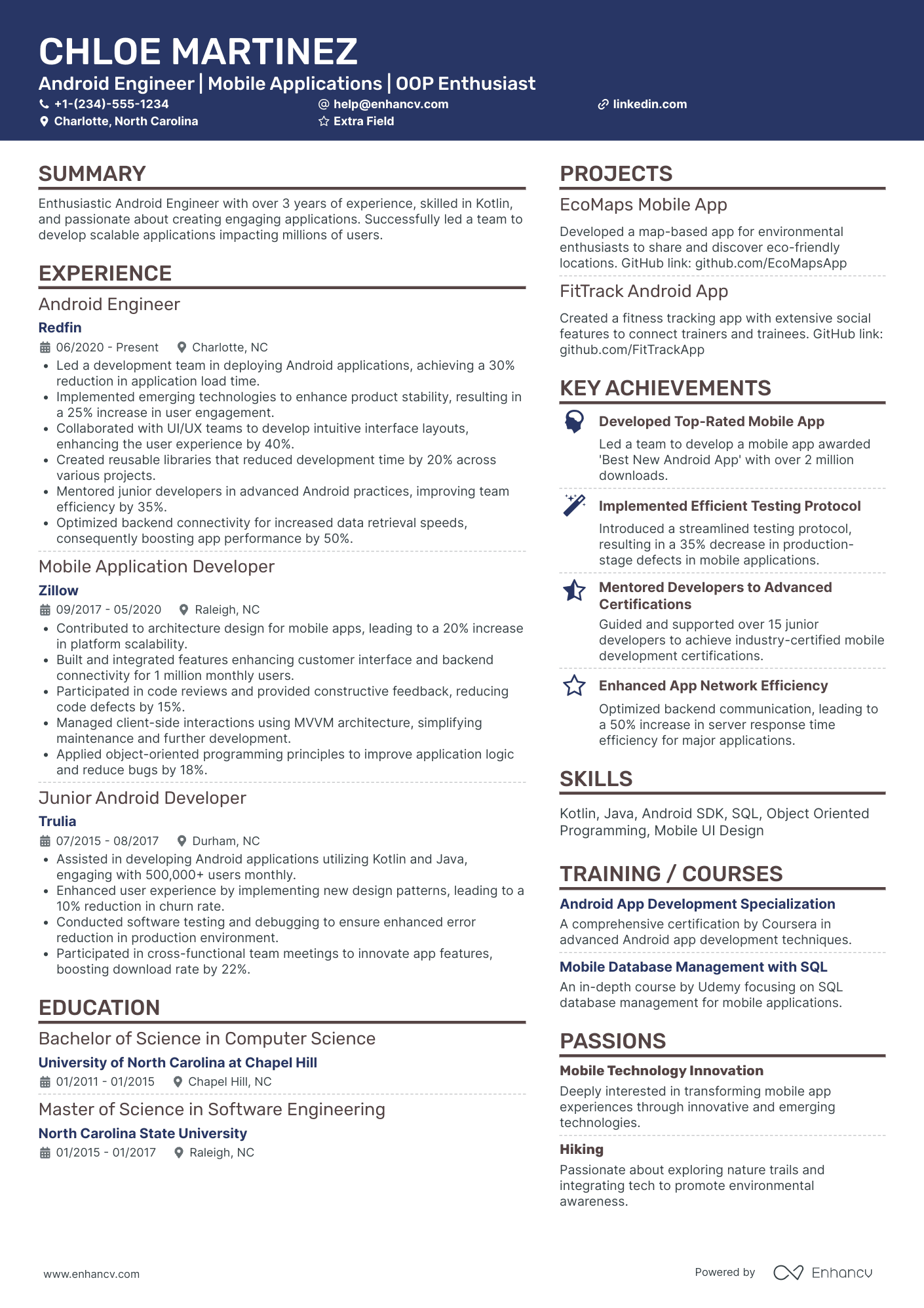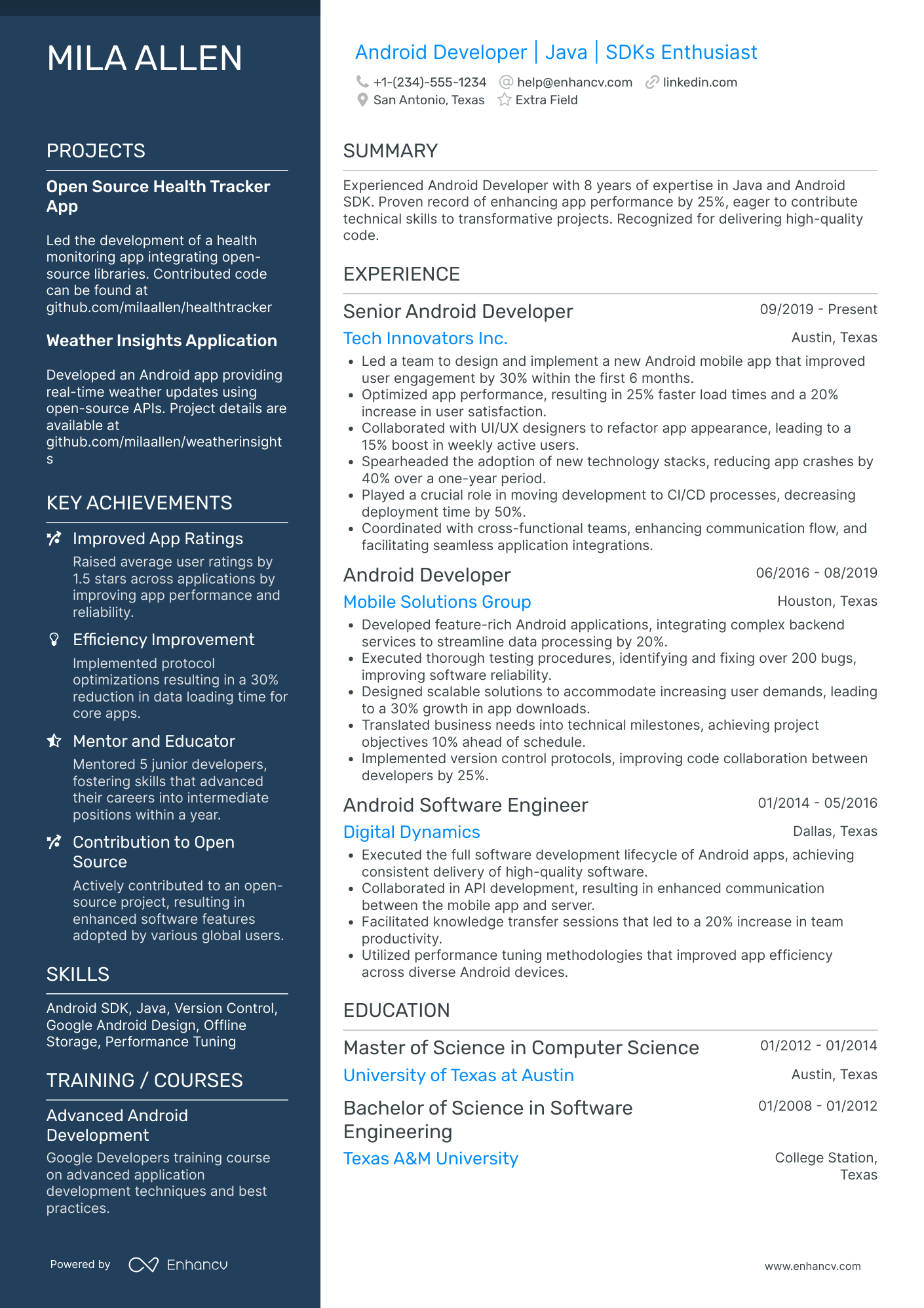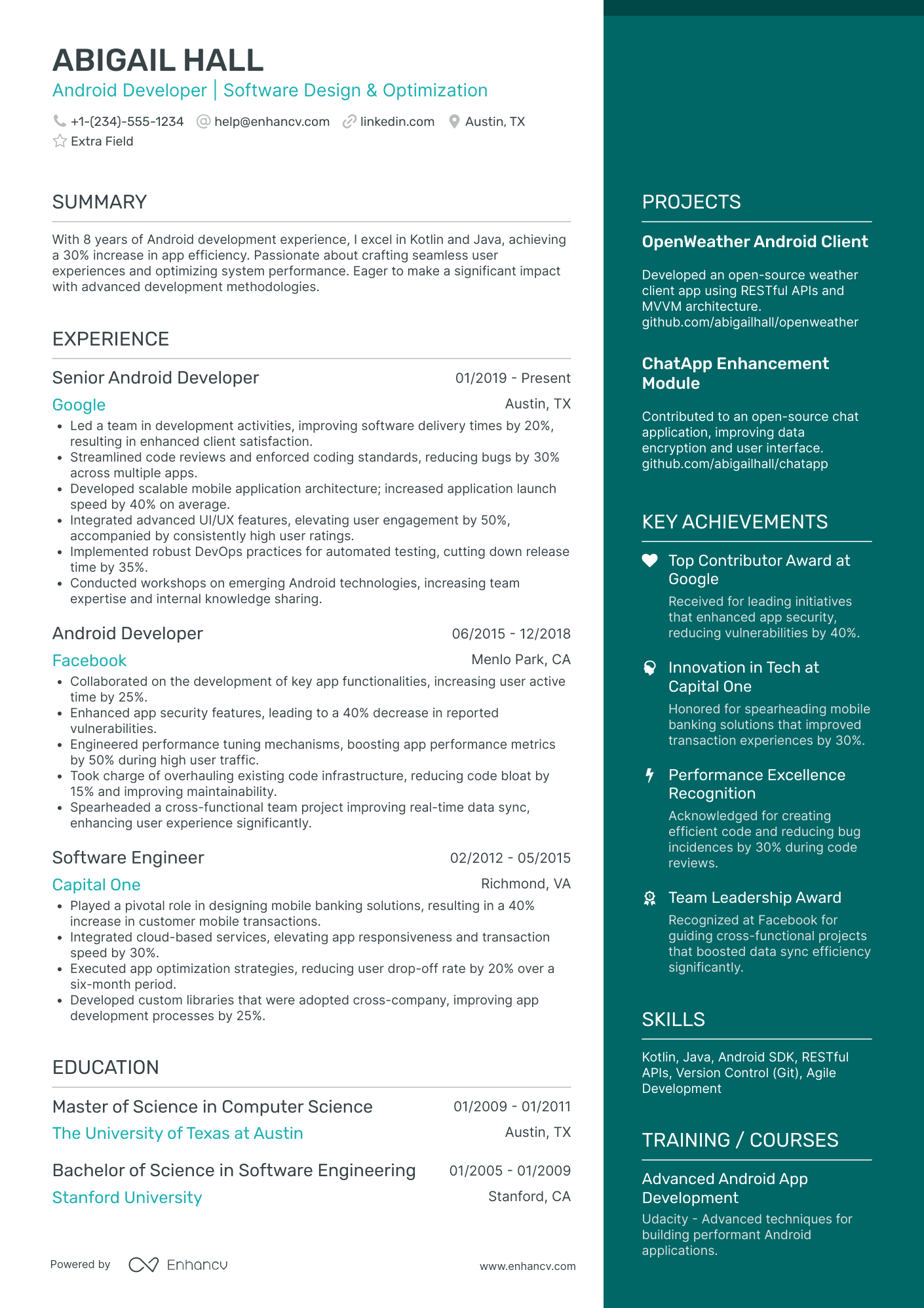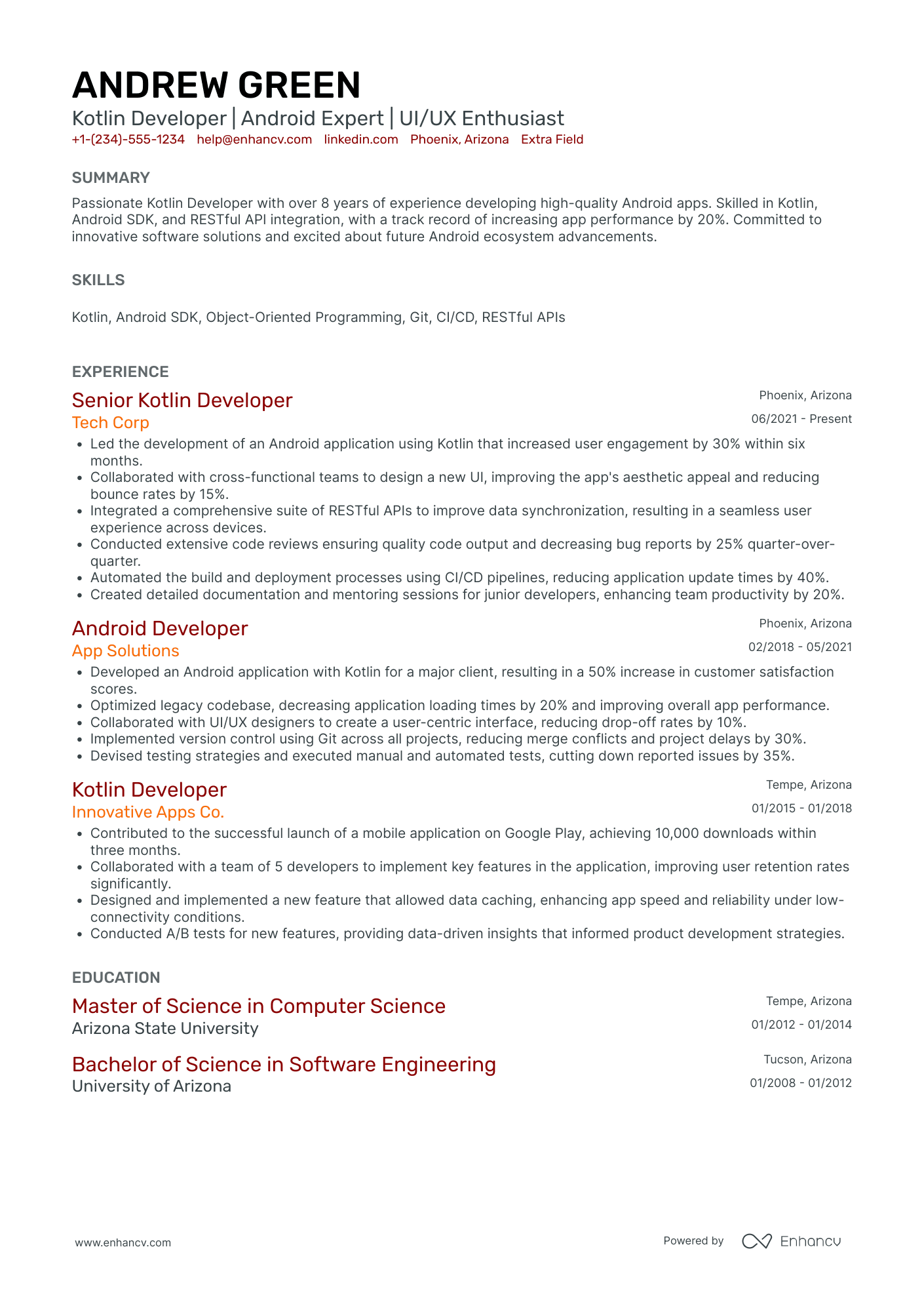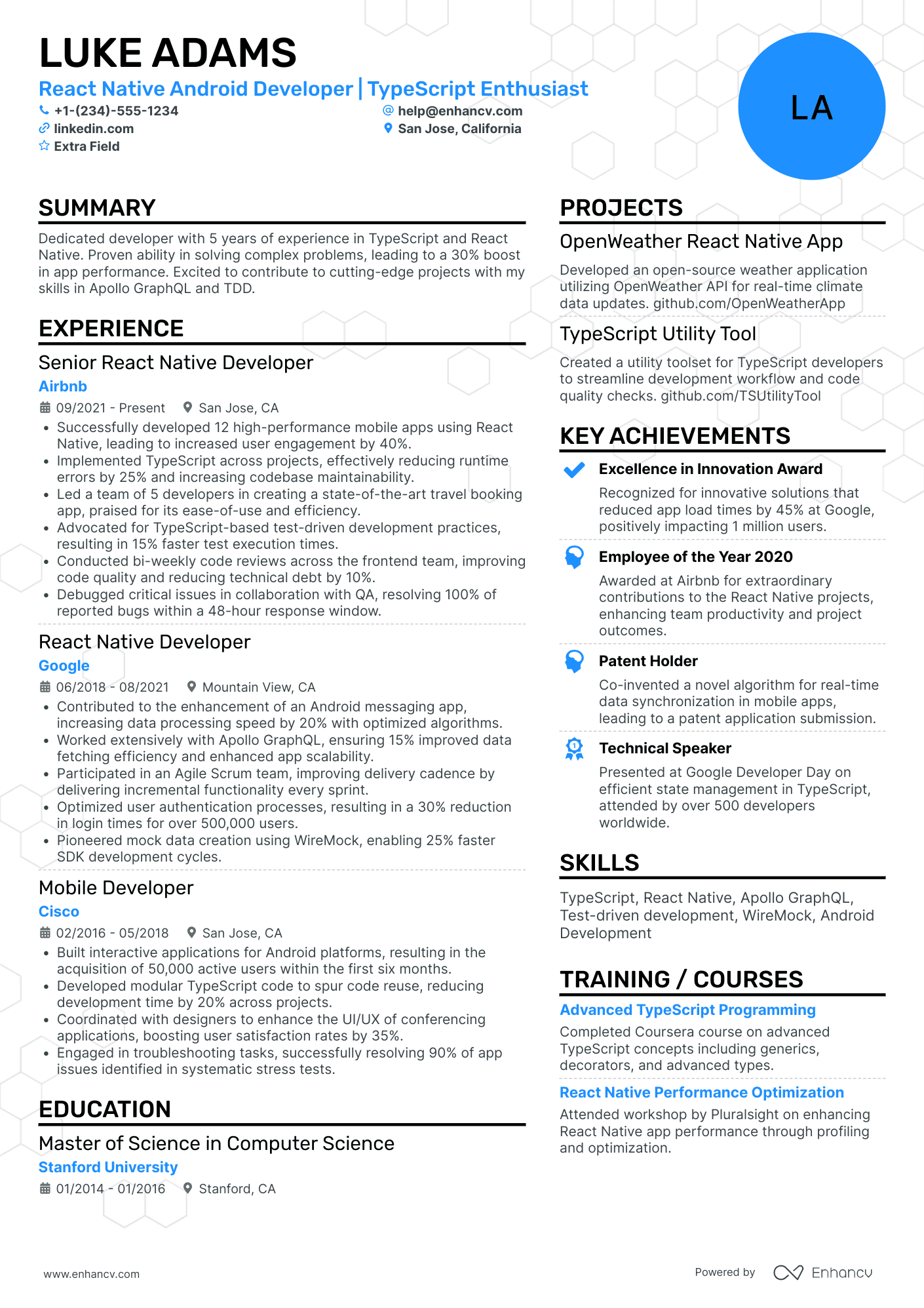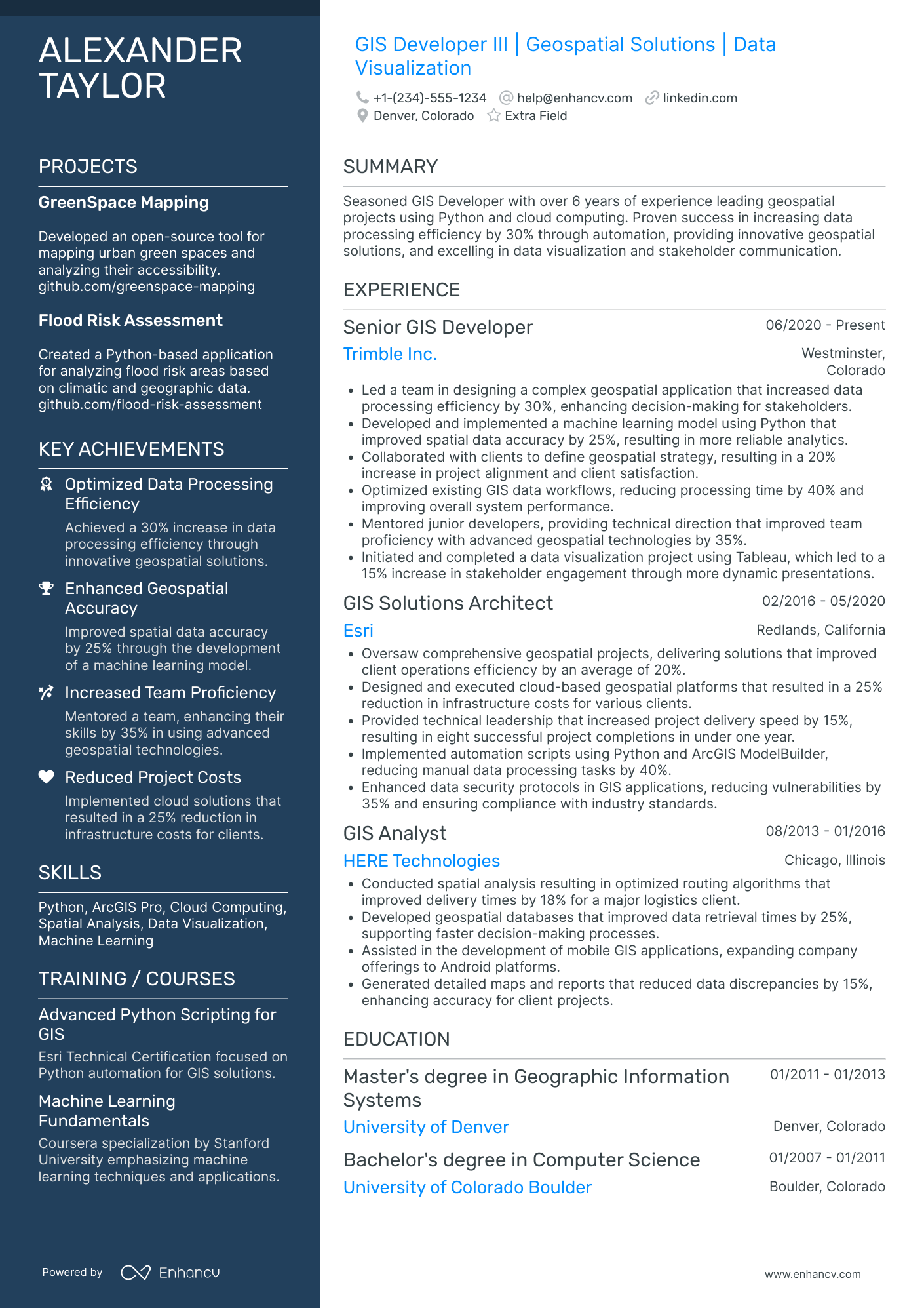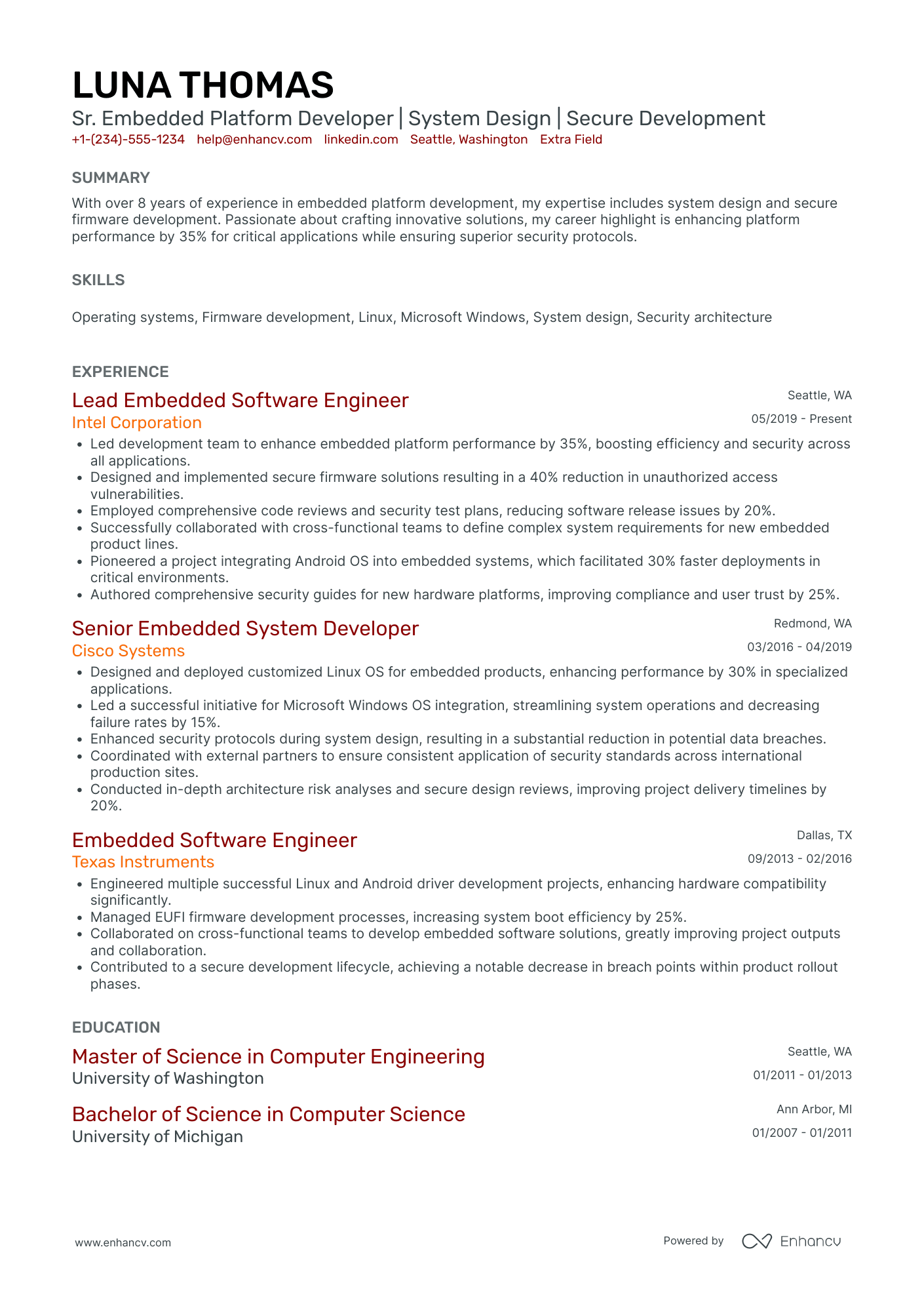The Android app market is a bit like a bustling city that's rapidly expanding—everyone wants a piece of the action because it covers more than 80% of the global market. This growth sparks tons of opportunities, particularly with the big names in app development that are scooping up much of the spotlight and resources.
What this landscape means for Android developers is that there's a stronger pull towards hiring seasoned pros. Newer devs might feel like they're in a holding pattern, waiting for their turn to shine as they navigate through a competitive field.
The key is staying resilient and continuously leveling up your resume. Think of it as upgrading your app to work flawlessly on every new version of Android that hits the market.
This guide will help you do just that. It’ll help you create a stellar Android developer resume by showing you how to:
- Choose a resume format that passes both automatic filters and human assessment.
- Structure your experience in a way that aligns with what employers want.
- Showcase your technical and interpersonal skills by providing concrete examples.
- Build a strong resume summary that shows your character and leaves recruiters willing to learn more.
- Decide what to include in your resume and what you can leave off.
- Craft a resume that's as elegantly coded in prose as it is in programming languages.
Before we dive in, you might want to explore our other development resume examples:
- Software QA Engineer Resume
- Software Support Engineer Resume
- SAP ABAP Developer Resume
- Embedded Software Engineer Resume
- Software Test Engineer Resume
- Senior PHP Developer Resume
- Software Programmer Resume
- Senior Oracle Developer Resume
- Software Development Engineer Resume
- Mobile Application Developer Resume
- Android developer Cover Letter
How to format an Android developer resume
If you’re wondering how to write an Android developer resume, focus on showcasing your tech stack and project experience. The best format generally depends on your specific background and experiences, but let’s talk about a couple of common approaches that work well for folks in Android development.
- Reverse-chronological format: This is the traditional resume format where you list your experience from most recent to oldest. It's straightforward and preferred by many hiring managers because it easily outlines your career progression. For each position, highlight your responsibilities and, more importantly, your achievements. For an Android developer, this might include apps you've developed, technologies you’ve mastered (like Kotlin or Java), and any impact your work had (like user ratings, downloads, or functionalities improved).
- Functional format: This one focuses more on your skills and specialties rather than the timeline of your employment. It’s especially useful if you have gaps in your employment or are early in your career without much work history. You can group your skills into categories like "Mobile App Development," "UI/UX Design," and "Project Management," detailing your competencies and achievements in each area. Include specific projects and the technologies used to give more context.
- Combination (hybrid) format: As the name suggests, this format combines elements of both reverse-chronological and functional resumes. It’s great for Android developers with a solid set of skills and a strong work history. You start with a powerful summary of your key skills and top achievements, then follow with your work history. This format lets you highlight your expertise right off the bat but also details your professional journey.
Targeting Canada? – Keep in mind their resume layout may differ from others.
For most Android developers, we recommend the hybrid format. It allows you to showcase your technical skills upfront. You can immediately highlight your proficiency in Android Studio, APIs, Java, Kotlin, and any other tools or languages you’re good with. It also helps you put a spotlight on specific projects or achievements that might get buried in a simple chronological listing. For example, if you developed an app that gained significant traction or featured new integrations, you can highlight it in the skills section.
Resume designs
- Template: We recommend opting for a double-column template, as it allows you to include more information in a compact format. This layout is also a popular choice for programming positions.
- Margins: Set your resume margins between 0.5 and 1 inch to make your document more organized and easy to read.
- Colors: Choose subtle, professional colors for your resume. Blue and gray are a safe choice in the tech industry.
- Fonts: Use readable, ATS-friendly resume fonts such as Arial, Rubik, or Lato, sized between 10 and 12 points. By the way, all the font options available on Enhancv’s resume builder pass through digital filters effortlessly, whether serif or sans serif.
- Length: One-page resumes are the best option for developers even though you may feel like you have a lot to say. If you carefully select which details to include in your resume, you’ll realize a one-page resume works just fine. (We’ll show you how to do that in a minute).
Resume header
- Contact information: Include your name, job title, and location at the top of your resume. Remember to add your professional email address.
- Links: Don’t forget to include a link to your LinkedIn profile, and more importantly, to your portfolio. You need to show off your code, so your Github or Google Play Store (The latter is especially useful as it allows employers and clients to see real user feedback on your work).
- Photo: It’s usually best to leave photos off your resume. This is done to avoid unconscious bias and keep the focus purely on your skills.
File format and naming
- Simple formatting: Avoid using graphics and tables as they can confuse ATS. If you're looking to add a creative touch to your application, you can use one of our fail-proof resume templates, which come with pre-approved style elements.
- File format: Save your resume as a PDF to maintain formatting across all devices and systems.
- Naming Convention: Name your file professionally, for example, ‘FirstNameLastNameAndroidDeveloper_Resume’.
If you already have a resume, feel free to run it through our AI-powered resume checker and see how it fares against a real ATS.
Is your resume good enough?
Drop your resume here or choose a file. PDF & DOCX only. Max 2MB file size.
Moving on, let us show you the must-have sections for your resume.
The top sections on an Android developer resume
- Technical skills: Detail your expertise in programming languages such as Java, Kotlin, and Android SDK.
- Professional experience: Show relevant job history and project impacts.
- Projects section: Highlight key apps developed and their features.
- Education and certifications: Include degrees and specific Android courses.
- Achievements: List awards and recognitions unique to tech contributions.
These resume sections offer hiring managers a comprehensive view of your expertise and character, Make sure you present yourself in the best possible light by providing information on all of the key elements below:
What recruiters want to see on your resume
- Proficiency in Android SDK and relevant programming languages (Java, Kotlin) to ensure you can handle the technical demands of the job.
- Experience with Android UI design principles and accessibility standards to create intuitive and user-friendly interfaces.
- Portfolio of published apps on the Google Play Store to demonstrate real-world application of skills and success in project completion.
- Knowledge of back-end programming and integration to show capability in managing full-stack development projects.
- Familiarity with version control systems like Git, which is crucial for collaborating on large codebases and maintaining code history.
Now that we have the basics covered, let’s proceed to the most substantial part of your resume—the experience section.
How to write your Android developer resume experience
The experience section is perhaps the most crucial element of your professional presentation, as it needs to answer job requirements while showcasing your technical expertise and personality.
Create your best resume experience section by:
- Only selecting experience relevant to the role you're applying for.
- Adding numbers and metrics to prove your achievements.
- Creating a narrative that showcases your Android developer career succession.
- Tailoring your entries to the requirements from the job description.
Take a look at a real-life job posting about an Android developer job:
We are looking for Android Mobile App Developers who will design the app based on product management specifications, implement connectivity to the backend components leveraging mobile SDKs, implement the user interface and other client-slide logic in native Google tools, and provide ongoing technical guidance. The ideal candidate is self-sufficient and will exhibit a high degree of initiative in learning new technologies and methods to resolve challenges encountered during the project life cycle.
RESPONSIBILITIES
- Developing mobile applications for Android (as well as server-side APIs)
- Writing coherent, organized code. The ideal candidates must be comfortable working on a complicated code-base with high levels of abstraction
- Working with Product Management to help define functional specifications for mobile applications
- Implementing multi-device application features as part of an interactive Agile development process
- Researching, adopting, and integrating new technologies
- Innovating and improving existing products and mobile app features
- Taking ownership of projects to ensure their successful completion with respect to deadlines
- Collaborating with Quality Assurance in developing a test plan to ensure successful deployment of updates
REQUIREMENTS
- B.A. or B.S. in Computer Science or similar engineering program with strong academic performance. Liberal arts academic experience or interests are also a plus.
- 0+ years of experience in Software Development, preferably in mobile development
- Self-starter, analytical, tenacious problem solver
- Strong verbal and written communication skills
- Rigorous attention to detail and focus on quality of deliverables
- Proven team experience and comfort in a team-oriented environment
- Passion for working with technology and excitement for creating high-quality consumer technology products
- For Android: Java, Kotlin, Android SDK
Let’s do a simple exercise on creating a targeted resume for this specific job ad. Below is a resume experience section that falls short:
- •Participated in meetings with the Quality Assurance team to address software bugs.
- •Assisted in some backend integration tasks to help improve app performance.
- •Participated in meetings with the Quality Assurance team to address software bugs.
- •Led a small team in a development project.
This experience section is pretty vague, isn't it? It doesn't specify what tools were used or any concrete results from the projects. Without those details, it's tough for hiring managers to get a real sense of what the candidate has accomplished or what they can bring to the table.
Now, let’s see how the same entry can be improved to look like a proper senior Android developer resume:
- •Designed 4 mobile applications using Java and Kotlin, adhering to modern Android SDK guidelines and resulting in 100,000+ downloads and an average user rating of 4.5 on the Google Play Store.
- •Engineered backend API integrations for 5+ mobile applications, increasing user engagement by 30% within the first three months post-launch.
- •Collaborated with Quality Assurance and reduced bugs by 40%, significantly improving deployment efficiency.
- •Managed a team of 5 developers on a project that received the Best Mobile Application of the Year award, recognized for innovation and performance.
Now this version definitely hits the mark! Here’s why it works so much better:
- Tailored to the job description: Each bullet point addresses specific requirements from the job posting. For instance, designing mobile applications using Java and Kotlin directly aligns with the job's need for experience in these languages.
- Use of action verbs: The bullets start with strong action verbs like "Designed," "Engineered," "Collaborated," and "Managed." These verbs add energy and clarity and describe the candidate's role in each project.
- Quantified achievements: The achievements here are quantified with impressive stats—100,000+ downloads, a 30% increase in user engagement, and a 40% reduction in bugs. These figures help illustrate the tangible impact of the candidate’s work.
- Highlights key competencies: Managing a team and being recognized with an award directly showcase leadership and excellence in the field, which are highly valued in any senior role.
Whether you’re an Android developer with 5 years of experience or just 1, you can create an equally impressive work history section. Check out our tips on adding numbers to your resume to learn how.
How to quantify impact on your resume
When you put numbers to your achievements, it helps potential employers see that you’re a player who adds real value. By showing that your work leads to measurable results, you’re not just ticking off tasks—you’re actively driving success and growth for their products and the company as a whole. Plus, quantifiable achievements are like gold during interviews. They give you great material to talk about, letting you dive into your successes, explain how you pulled them off, and show how you tackle challenges.
Below are a few suggestions on how you can amplify your Android developer resume:
- Include the number of app downloads to demonstrate the market reach and acceptance of your work.
- Mention user retention rates to show your ability to build engaging and valuable applications that keep users coming back.
- Detail the percentage increase in app performance after optimizations to illustrate your effectiveness in enhancing application speed and efficiency.
- Specify the reduction in crash rates to highlight your skills in improving app stability and reliability.
- List the number of features implemented per project to showcase your productivity and capability in delivering complex functionalities.
- State the percentage growth in user ratings after updates to indicate your success in responding to user feedback and improving the app experience.
- Report the savings achieved through code refactoring in terms of memory usage or load times to show your contribution to cost efficiency.
- Quantify the impact of new features on sales or ad revenue to demonstrate how your technical contributions directly boost business outcomes.
By incorporating quantified impacts, Android app developers can better communicate their professional value and potential, making their resumes stand out in a crowded field even if they’re just starting out.
How do I write an Android developer resume with no experience
Before you do anything else, take a tip from a self-taught developer and start building your app portfolio. This could be crucial in landing you an interview, especially if you lack prior experience.
Building your first resume as an Android developer is about positioning yourself as a capable and motivated candidate who has a solid foundation and a strong desire to learn. Having no experience doesn’t mean you have nothing relevant to add to your resume. For example:
- Focus on relevant projects: Just showcase the projects you've done so far. Talk about the apps you've developed, whether for class, as a hobby, or during internships. Describe what these apps do, the tools you used, and any positive feedback or downloads you've gotten.
- Emphasize education and certifications: Got a degree in computer science or something similar? Perfect, mention that. Also, toss in any relevant certifications you've picked up, like Google’s Associate Android developer certification. These are real resume boosters.
- Include technical skills: Make sure to list out the programming languages you're good with—Java, Kotlin, you name it—and don't forget tools like Android Studio. This part is key; it lets potential employers quickly see what you can handle.
- Add hackathons and competitions: Ever dive into hackathons or coding competitions? Awesome—include that. It shows off your coding passion and your cool under pressure, which are big pluses.
- Objective statement: Kick off your resume with a bang! Craft a quick intro that sums up who you are as a developer, what skills you bring to the table, and what you're looking to do next. Think of it as your personal pitch. You may be an Android developer with 1 year of experience behind you, but your motivation should be tenfold.
Keep learning and updating. The world of Android development moves fast. Keep up with new tech and techniques, and keep tweaking your resume as you learn new stuff. It shows you’re committed to staying relevant.
How to show your Android developer skills on a resume
So you’ve chosen a fast-paced field? Awesome, just remember to reflect all the new tech you’re well-versed in on your resume. When approaching your skills section, think of it as a project in progress. This is why it makes sense to subscribe to a resume-building platform that allows you to create multiple documents and customize them to specific job descriptions.
First things first, you need a solid hard skills section. This is where you list all the technologies you’re proficient in, making sure key requirements from the job description are placed front and center.
Best hard skills for an Android developer resume
- Java
- Kotlin
- Android SDK
- Android Studio
- XML
- Gradle
- Git
- RESTful APIs
- JSON
- SQLite
- Firebase
- Google Play Services
- Retrofit
- MVVM architecture
- Material Design
- Dagger 2
- RxJava
- Espresso
- Flutter
- React Native
Soft skills are equally important, but they don't fit well when isolated in a dedicated section. Here’s a better approach:
- Identify keywords from the job description.
- Consider which ones you genuinely possess (but be honest about your skills).
- Incorporate these skills throughout different sections of your resume, like the experience or summary sections.
- Provide evidence to demonstrate that you truly possess each skill.
For example, to talk about your customer-centric approach, you can write “Regularly consulted with end-users to understand their challenges, leading to user-centric design improvements that increased app satisfaction ratings by 25%.”
Best soft skills for your Android developer resume
- Problem-solving
- Critical thinking
- Teamwork
- Communication
- Adaptability
- Attention to detail
- Time management
- Creativity
- Initiative
- Empathy
- Patience
- Leadership
- Conflict resolution
- Resilience
- Open-mindedness
- Perseverance
- Customer focus
- Analytical skills
- Decision making
- Emotional intelligence
Now that we’ve got your resume skill set covered, let’s move on to your educational background.
How to list education and certifications on a dev’s resume
The education and certification resume sections also matter for an Android developer resume. They show recruiters that you've invested time to gain specific know-how, vital for growth.
As far as the resume education section is concerned:
- Detail only advanced education, specifying the institution and the duration of your studies.
- Skip degrees that don't align with the job's requirements.
- Offer a description of your academic journey if it underscores any notable achievements.
Like so:
- •Winner of the Collegiate Programming Contest, showcasing advanced problem-solving and coding skills.
- •Developed an award-winning mobile app for campus navigation and event management, enhancing student engagement and participation.
When curating your degrees and certificates on your resume:
- Select only the accreditations that matter for the role.
- Consider including niche knowledge that could help you stand out as a candidate (better listed toward the top of your resume).
- Feel free to omit your GPA (especially if it’s under 3.5) and any specializations that have nothing to do with the technical or soft skills required for the job.
These two sections could help you have a better competitive edge over other candidates. Recruiters find all of the following Android developer credentials impressive:
Top certifications for your Android developer resume
Next, we explore how to write a stand-out resume profile that succinctly describes your strengths and credentials.
How to write your Android developer resume summary or objective
Deciding whether to include a resume summary or an objective is crucial. Both serve as key introductory elements at the top of your resume, encapsulating your profile in up to five sentences and incorporating relevant keywords from the job ad.
Here are the key differences between the two:
- The resume summary is best suited for senior Android developer resumes. It focuses on aligning your achievements and experience with the job requirements. It provides recruiters with a snapshot of your expertise, helping you stand out as an ideal candidate for the role.
- The resume objective, on the other hand, is for Android developers with 1 or 2 years of experience. It centers on your career goals and aspirations, detailing how the role aligns with your career progression. It's particularly suitable for candidates with less professional experience or those new to the job market.
Below are examples of a resume summary and an objective that will make a strong first impression on your Android developer resume.
Optimize your resume summary and objective for ATS
Drop your resume here or choose a file.
PDF & DOCX only. Max 2MB file size.
Junior Android developer objective
Here are three reasons why this resume objective is a good example:
- Relevant certification highlighted: Including the Google Associate Android developer (AAD) certification immediately shows that the candidate has a recognized qualification specific to Android development, which enhances credibility and relevance in the eyes of potential employers.
- Clear transition explanation: The objective successfully communicates the candidate's transition from front-end web development to Android development. This showcases the candidate’s ability to adapt and grow.
- Focus on application and enthusiasm: The objective emphasizes the candidate's eagerness to apply their skills and passion for mobile technology in developing high-quality Android applications. This highlights their motivation and aligns their personal interests with the goals of potential employers in the tech industry.
Senior Android developer summary
Here’s why this is a good example of a resume summary:
- Tailored expertise: The summary zeroes in on the candidate’s development work in the healthcare and finance sectors. This shows they're not just a great developer but also someone who understands the unique challenges and needs of these industries, making them an ideal match for companies in these areas.
- Skill showcase: It lays out their proficiency in Java, Kotlin, and Android SDK clearly, signaling to employers that they have the technical chops needed for high-level Android development.
- Impressive achievements: The mention of spearheading an app launch that hit over 1 million downloads in just a month is a real eye-catcher. It highlights their ability to lead projects that make a splash, demonstrating their potential to do the same for future employers.
To sum up, here are the dos and don’ts when it comes to resume profiles:
DON’TS
Don’t be vague and generic to avoid landing in the rejection pile.
Don’t use personal pronouns to avoid sounding too arrogant.
Don’t mention irrelevant experience that would distract from your real strengths.
DOS
Do include keywords from the job description to pass ATS and recruiters’ assessment.
Do provide tangible results from your achievements.
Do use power adjectives that describe you and your professional accomplishments.
Additional sections for an Android developer resume
What most candidates don't realize is that their Android developer resumes should be tailored both to the job and their own skillset and personality.
To achieve this balance between professional and personal traits, you can add various other sections to your resume. However, do this only if space allows and after you’ve taken care of the must-have sections we discussed earlier in this guide.
Your potential employers may be impressed by your:
- Awards: spotlight any industry-specific achievements and recognitions that have paved your path to success.
- Languages: dedicate some space on your Android developer resume to list your multilingual capabilities, alongside your proficiency level.
- Publications: provide links and descriptions to both professional and academic ones, relevant to the role.
- Your prioritization framework: include a "My Time" pie chart that shows how you spend your at-work and free time. This would serve to further back up your organizational skill set.
Most importantly, if you’ve been working in app development for a while and have built several impressive apps, you’ll definitely need a projects section on your resume.
How to put a projects section on a resume
Having a projects section on your resume is like your own personal showcase, giving potential employers a front-row seat to your technical creativity. Projects are concrete evidence of your abilities and a way to prove that you can walk the walk.
So, when building this section, think of it as a way to tell the story about a challenge you faced, the innovative approach you took, and the successful outcome you achieved. This shows employers that you’re not just a coder, but a problem solver who can think on their feet and handle the nitty-gritty of real-world applications.
Use the following steps:
- Place the name of the project at the top.
- Add duration dates and location.
- Optionally, include a short description of the project.
- Within up to three bullet points, describe your contribution to the project.
- •Developed a comprehensive health tracking app using Kotlin and Android Studio, integrating Google Fit APIs.
- •Implemented real-time health data synchronization across multiple devices, enhancing user engagement by 40%.
- •Optimized app performance, achieving a 99.5% crash-free rate across 50,000 active users.
- •Created a user-friendly budget planning app with Java and SQLite for secure financial data management.
- •Integrated push notifications and reminders for budget tracking, resulting in a 30% increase in monthly user retention.
- •Led a team of 3 developers, fostering a collaborative environment and delivering the project on schedule.
Key takeaways
So, there you have it—crafting your resume might feel a bit like debugging complex code at times, but with these takeaways, you’re set to make your skills shine and your achievements pop.
- Choose a resume layout that allows your tech skills and creativity to stand out.
- Carefully curate your resume content—select only what best meets the employer’s requirements and makes it through the ATS without crashing.
- Provide concrete examples of your skills and achievements through specific numbers.
- Decide which parts of your educational background to feature in your resume and which certifications to prioritize.
- Create an effective resume summary that’s packed with relevant information.
- Don’t forget to highlight your projects—they’re the real MVPs of your resume.
Android Developer resume examples
By Experience
By Role

